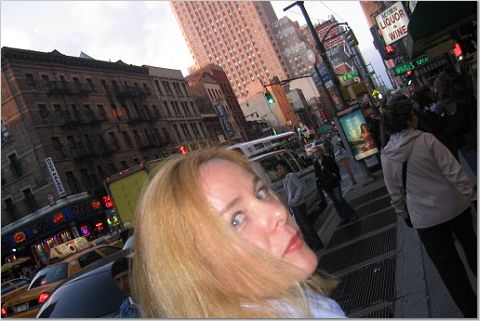 Hey all! I've moved the whole dog and pony show over to
Hey all! I've moved the whole dog and pony show over to www.polisnyc.wordpress.com
Much better design, better organization, all around big improvement. So come take a look!
New York City, Ground Up: The built, the virtual, the bizarre, the wonderful.
 Hey all! I've moved the whole dog and pony show over to
Hey all! I've moved the whole dog and pony show over to  The automat has returned with the grand opening of BAMN! Drawing a big crowd on St. Marks Pl. this evening, people lined up to experience the pre-fast food phenomenon of dropping a coin in a slot and having fresh hot food appear like magic. According to a surprisingly good New York Sun article, in the 1950s there were 180 automats in New York and Philadelphia, feeding 800,000 people a day such things as beef noodles with burgundy sauce. The last automat, in Times Square, closed in 1991. The 21st century version -- complete with hot pink signage and even hotter concierges (click pic at left) --
The automat has returned with the grand opening of BAMN! Drawing a big crowd on St. Marks Pl. this evening, people lined up to experience the pre-fast food phenomenon of dropping a coin in a slot and having fresh hot food appear like magic. According to a surprisingly good New York Sun article, in the 1950s there were 180 automats in New York and Philadelphia, feeding 800,000 people a day such things as beef noodles with burgundy sauce. The last automat, in Times Square, closed in 1991. The 21st century version -- complete with hot pink signage and even hotter concierges (click pic at left) --  will serve grilled cheese, pizza and dumplings with an Asian twist for $1.50-$2.50. Once the crowds disperse a little, I'll give it a whirl and write up a review.
will serve grilled cheese, pizza and dumplings with an Asian twist for $1.50-$2.50. Once the crowds disperse a little, I'll give it a whirl and write up a review.
 Andy Roddick - who is now receiving wisdom from the legendary Jimmy Connors - just pummeled Florent Serra (6-2 6-1 6-3). This is a decidedly better start for Roddick in Flushing, Queens than last year. After a big advertising build-up, he was dismissed from the US Open in the first round by a player ranked only 70th in the world. This year looks to be a whole lot different. With Jimbo in the house, not only is Roddick playing confidently, he got lucky with an easy draw. I predict he'll meet Rafael Nadal in the quarters (which will be a screamer of a match), and defeat him to go on to the face Roger Federer in the final. The downside: Roddick could face Agassi in the fourth round, at which point, Agassi will likely bid a a fond farewell (if he hasn't already).
Andy Roddick - who is now receiving wisdom from the legendary Jimmy Connors - just pummeled Florent Serra (6-2 6-1 6-3). This is a decidedly better start for Roddick in Flushing, Queens than last year. After a big advertising build-up, he was dismissed from the US Open in the first round by a player ranked only 70th in the world. This year looks to be a whole lot different. With Jimbo in the house, not only is Roddick playing confidently, he got lucky with an easy draw. I predict he'll meet Rafael Nadal in the quarters (which will be a screamer of a match), and defeat him to go on to the face Roger Federer in the final. The downside: Roddick could face Agassi in the fourth round, at which point, Agassi will likely bid a a fond farewell (if he hasn't already). It’s easy to love Andre Agassi these days, this being his 20th straight appearance at
It’s easy to love Andre Agassi these days, this being his 20th straight appearance at  Cary of Visual Diaries started a unique blog while Polis was on hiatus, so I'm just getting to it now. The angle -- no pun intended -- is that he's a double shooter: pool and photography (works for the Village Voice and the Times, the latter is how we met). And now he's combined the two passions in a blog, Bank the Nine: Some Observations from a Pool-Playing Photographer. Who knew there were outdoor pool tables in Battery Park? Read all about it here.
Cary of Visual Diaries started a unique blog while Polis was on hiatus, so I'm just getting to it now. The angle -- no pun intended -- is that he's a double shooter: pool and photography (works for the Village Voice and the Times, the latter is how we met). And now he's combined the two passions in a blog, Bank the Nine: Some Observations from a Pool-Playing Photographer. Who knew there were outdoor pool tables in Battery Park? Read all about it here.
 The Times has a great little slideshow about nature adapting to the urban world, from flowers poking through cracked cement in Williamsburg to monk parakeets nesting on power poles -- which, according to legend, arrived in the region in the 1960s when a shipment of the birds fell off a plane at Kennedy Airport. To view Andrea Mohin's slideshow, click here.
The Times has a great little slideshow about nature adapting to the urban world, from flowers poking through cracked cement in Williamsburg to monk parakeets nesting on power poles -- which, according to legend, arrived in the region in the 1960s when a shipment of the birds fell off a plane at Kennedy Airport. To view Andrea Mohin's slideshow, click here. So good to be back in NYC after a hiatus in Cleveburgh (my hometown, see below). A quick tour around the nabe yielded sights, sounds and smells that can only be had in the E.Vil., including this sidewalk trash montage that looks like one of those faked photo-ops that newspaper journalists used to stage back in the day. The streets of the E.Vil. are littered (literally!) with failed screenplays, as seen on E. 9th Street (note the Mud to-go coffee cup). I googled the authors and the screenplay title but alas, did not come up with much. Here's a thought: The first open-source screenplay writing contest. Start with the title Super Duper and take it from there. Or not.
So good to be back in NYC after a hiatus in Cleveburgh (my hometown, see below). A quick tour around the nabe yielded sights, sounds and smells that can only be had in the E.Vil., including this sidewalk trash montage that looks like one of those faked photo-ops that newspaper journalists used to stage back in the day. The streets of the E.Vil. are littered (literally!) with failed screenplays, as seen on E. 9th Street (note the Mud to-go coffee cup). I googled the authors and the screenplay title but alas, did not come up with much. Here's a thought: The first open-source screenplay writing contest. Start with the title Super Duper and take it from there. Or not.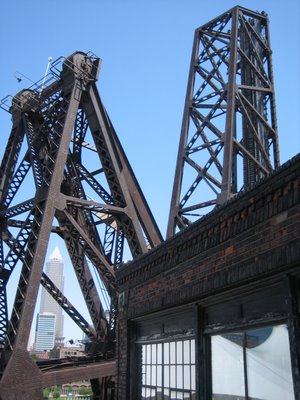 As I already mentioned, the river that divides the east and west side of C-town (putting the cleave in Cleveland, I suppose) is called the Cuyahoga, which is an Indian word for crooked because the river takes several crazy turns through downtown and further south. There are more than 330 bridges spanning the river, many of them quite beautiful, especially the moveable ones. Not all are still in use, such as Baltimore & Ohio Railroad Bridge called a jackknife (pic above taken this afternoon), built in 1956. Below is a view I took from the Center Street bridge, one of the few swing bridges in the country that is still in use -- although it's been rebuilt several times, the current version completed in 1901. It was originally wood and became the central point of contention between eastsiders and westsider, who fought a war with each other over which side of the river downtown Cleveland would be established. The eastsiders won, and downtown can be seen looking east, with views of the B&O on the left; Key Tower in the center (the tallest building in Cleveland, designed by Cesar Pelli); and a glimpse of the Detroit-Superior Bridge on the right, completed in 1918. Not that you want to, but to read more about The Bridges of Cuyahoga County, click here.
As I already mentioned, the river that divides the east and west side of C-town (putting the cleave in Cleveland, I suppose) is called the Cuyahoga, which is an Indian word for crooked because the river takes several crazy turns through downtown and further south. There are more than 330 bridges spanning the river, many of them quite beautiful, especially the moveable ones. Not all are still in use, such as Baltimore & Ohio Railroad Bridge called a jackknife (pic above taken this afternoon), built in 1956. Below is a view I took from the Center Street bridge, one of the few swing bridges in the country that is still in use -- although it's been rebuilt several times, the current version completed in 1901. It was originally wood and became the central point of contention between eastsiders and westsider, who fought a war with each other over which side of the river downtown Cleveland would be established. The eastsiders won, and downtown can be seen looking east, with views of the B&O on the left; Key Tower in the center (the tallest building in Cleveland, designed by Cesar Pelli); and a glimpse of the Detroit-Superior Bridge on the right, completed in 1918. Not that you want to, but to read more about The Bridges of Cuyahoga County, click here.
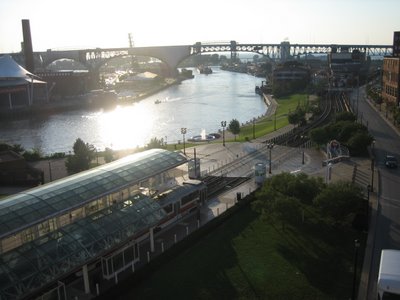 One of the reasons Polis is on summer hiatus is because I'm actually not in New York, but in Cleveland. The above photo is where Moses Cleaveland* landed in 1796, taken from the Detroit Superior Bridge, which spans the Cuyahoga River. The Cuyahoga -- an Indian word for crooked, the river does a loop-d-loop through downtown -- became infamous in 1969 for catching on fire. It actually had caught fire many times, but this particular fire was covered by Time magazine, which described the Cuyahoga as the river "that oozes rather than flows," in which a person "does not drown but decays." The Clean Water Act and other environmental laws were subsequently enacted, and it has been cleaned up considerably, as have many other urban waterways as a result. But the metaphor of a burning river lives on. There's the Burning River Fest, a music fest with an environmental awareness mission; a really good beer made by Great Lakes Brewery, Burning River Pale Ale; and a book entitled Crooked River Burning. Sadly, when a performance artist once proposed an event to recreate the river catching on fire, the city didn't see the humor in that and nixed the idea.
One of the reasons Polis is on summer hiatus is because I'm actually not in New York, but in Cleveland. The above photo is where Moses Cleaveland* landed in 1796, taken from the Detroit Superior Bridge, which spans the Cuyahoga River. The Cuyahoga -- an Indian word for crooked, the river does a loop-d-loop through downtown -- became infamous in 1969 for catching on fire. It actually had caught fire many times, but this particular fire was covered by Time magazine, which described the Cuyahoga as the river "that oozes rather than flows," in which a person "does not drown but decays." The Clean Water Act and other environmental laws were subsequently enacted, and it has been cleaned up considerably, as have many other urban waterways as a result. But the metaphor of a burning river lives on. There's the Burning River Fest, a music fest with an environmental awareness mission; a really good beer made by Great Lakes Brewery, Burning River Pale Ale; and a book entitled Crooked River Burning. Sadly, when a performance artist once proposed an event to recreate the river catching on fire, the city didn't see the humor in that and nixed the idea.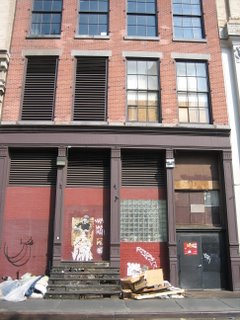 Given the insane real estate market in New York City, abandoned and/or underutilized buildings aren't the problem they once were, but they do still exist. City Limits is reporting that Scott Stringer, the Manhattan Borough President, is undertaking the first ever survey of abandoned properties in Manhattan. Prompted by homeless activists, Stringer's office will unleash a cadre of volunteers this Saturday, who will identify buildings such as 190 Mercer St. (which is certainly underutilized, if not entirely abandoned). According to City Limits, other cities have conducted similar surveys with good results:
Given the insane real estate market in New York City, abandoned and/or underutilized buildings aren't the problem they once were, but they do still exist. City Limits is reporting that Scott Stringer, the Manhattan Borough President, is undertaking the first ever survey of abandoned properties in Manhattan. Prompted by homeless activists, Stringer's office will unleash a cadre of volunteers this Saturday, who will identify buildings such as 190 Mercer St. (which is certainly underutilized, if not entirely abandoned). According to City Limits, other cities have conducted similar surveys with good results: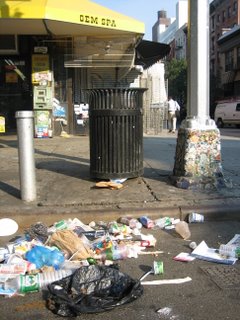 According to an article in today's Times, City Council is about to vote on Bloomberg's long-standing plan to deal with the 50,000 tons of trash generated in New York City every day. So now that the macro-trash plan is about to pass, can we talk about the micro-trash issue?
According to an article in today's Times, City Council is about to vote on Bloomberg's long-standing plan to deal with the 50,000 tons of trash generated in New York City every day. So now that the macro-trash plan is about to pass, can we talk about the micro-trash issue?
 I happened upon a skate contest in Tompkins Square Park today sponsored by two companies I've never heard of (this is getting to be a theme -- perhaps I'm in the wrong demographic): Boost Mobile and éS, which produces the "éS Game of SKATE," based on the basketball game "HORSE." The first skater performs a trick, and if completed, the skater she is playing has to do that trick. If she does not complete the established trick, she receives a letter. The first letter is "S," the second letter is "K", and so on, until "S-K-A-T-E" is spelled out and that person is out of the game. Anyhoo, it turns out Boost Mobile is owned by Nextel and éS is a footwear brand. Who knew. (Or more importantly, who cares? I just like the photo. Click to enlarge.)
I happened upon a skate contest in Tompkins Square Park today sponsored by two companies I've never heard of (this is getting to be a theme -- perhaps I'm in the wrong demographic): Boost Mobile and éS, which produces the "éS Game of SKATE," based on the basketball game "HORSE." The first skater performs a trick, and if completed, the skater she is playing has to do that trick. If she does not complete the established trick, she receives a letter. The first letter is "S," the second letter is "K", and so on, until "S-K-A-T-E" is spelled out and that person is out of the game. Anyhoo, it turns out Boost Mobile is owned by Nextel and éS is a footwear brand. Who knew. (Or more importantly, who cares? I just like the photo. Click to enlarge.)
 All the little worlds that exist out there, totally unbeknownst to 99 percent of the rest of humanity ... I had seen posts on Curbed about a couple of enterprising people selling Strawberry Shortcake on the boardwalk at Coney Island. Seemed cute enough to ignore. That is, until this morning when I looked at their blog a little more closely, and -- seeing the pure joy captured on their customers' faces, a small bit of loveliness at a time when we seem to be on the verge of WWIII -- I got curious. Who are these dispenders of joy, figurative and virtual, via Strawberry Shortcake and the Internet? I'm still not entirely sure, but according to their website, they are street artists operating under the moniker Thundercut as well as publishers of the zine Sherbert (nominated by Utne Reader for an Independent Press Award, their latest issue is fresh off the presses). Never heard of them (but perhaps that's not saying much). Ah well, nevermind. Just enjoy the Shortcake.
All the little worlds that exist out there, totally unbeknownst to 99 percent of the rest of humanity ... I had seen posts on Curbed about a couple of enterprising people selling Strawberry Shortcake on the boardwalk at Coney Island. Seemed cute enough to ignore. That is, until this morning when I looked at their blog a little more closely, and -- seeing the pure joy captured on their customers' faces, a small bit of loveliness at a time when we seem to be on the verge of WWIII -- I got curious. Who are these dispenders of joy, figurative and virtual, via Strawberry Shortcake and the Internet? I'm still not entirely sure, but according to their website, they are street artists operating under the moniker Thundercut as well as publishers of the zine Sherbert (nominated by Utne Reader for an Independent Press Award, their latest issue is fresh off the presses). Never heard of them (but perhaps that's not saying much). Ah well, nevermind. Just enjoy the Shortcake.
 I've been a big fan of Gapingvoid for a long time now, and in fact I've tried several times to make contact with Hugh about using his cartoons in my book (he keeps ignoring me! wassup?). So here's my shameless attempt at getting his attention: a big fat shout out.
I've been a big fan of Gapingvoid for a long time now, and in fact I've tried several times to make contact with Hugh about using his cartoons in my book (he keeps ignoring me! wassup?). So here's my shameless attempt at getting his attention: a big fat shout out.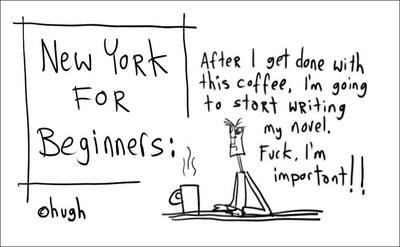
 The Governor's Island Alliance has released guidelines to redevelop perhaps the most important piece of undeveloped land in the Northern hemisphere, and there are three illustrated alternatives that can be voted on by going here: www.governorsislandalliance.org
The Governor's Island Alliance has released guidelines to redevelop perhaps the most important piece of undeveloped land in the Northern hemisphere, and there are three illustrated alternatives that can be voted on by going here: www.governorsislandalliance.orgGondolas to Gov's Island [Polis]
 When I was in LIC (see below), I came across something that I'm probably the last person to know about... Five Pointz, a building in Long Island City that got tagged with graffiti so often, the owner of the building decided like ten years ago to sanction the urban artists and let them do their thing. Now it's probably the most important collection of urban art in New York (and hence, the world). An artist who was about to go up in the lift to do a piece said that there's going to be -- get this -- a coffee table book about all the artists and the work on the building.
When I was in LIC (see below), I came across something that I'm probably the last person to know about... Five Pointz, a building in Long Island City that got tagged with graffiti so often, the owner of the building decided like ten years ago to sanction the urban artists and let them do their thing. Now it's probably the most important collection of urban art in New York (and hence, the world). An artist who was about to go up in the lift to do a piece said that there's going to be -- get this -- a coffee table book about all the artists and the work on the building.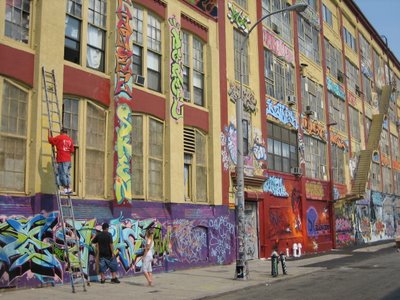
 A year ago, I reported on the largest green roof in New York City being installed on top of Silvercup Studios in Long Island City near the Queensboro Bridge. (Silvercup is the largest film and television studio in New York, where Sex and the City was filmed and the Sopranos still is. If you don't have Times Select, email me and I'll send a PDF of the Silvercup greenroof story for the Times.)
A year ago, I reported on the largest green roof in New York City being installed on top of Silvercup Studios in Long Island City near the Queensboro Bridge. (Silvercup is the largest film and television studio in New York, where Sex and the City was filmed and the Sopranos still is. If you don't have Times Select, email me and I'll send a PDF of the Silvercup greenroof story for the Times.) Silvercup Sunset [Polis]
Silvercup Sunset [Polis]
 While we're on the topic of irony too rich to require comment (see below), Gawker made a time-lapse video out of photos taken of the World Trade Center site over the past 101 days so we can watch absolutely nothing happen. It's a much more concise way of conveying what took me 2500 words in a piece I wrote for the July issue of Planning magazine entitled, Idling At Zero (which is not available online to non-members, so email me if you'd like to read it ... for the two Polis readers who are American Planning Association members, click here.).
While we're on the topic of irony too rich to require comment (see below), Gawker made a time-lapse video out of photos taken of the World Trade Center site over the past 101 days so we can watch absolutely nothing happen. It's a much more concise way of conveying what took me 2500 words in a piece I wrote for the July issue of Planning magazine entitled, Idling At Zero (which is not available online to non-members, so email me if you'd like to read it ... for the two Polis readers who are American Planning Association members, click here.).
 The irony of the above pic (snapped on Avenue A this afternoon) requires no further comment, but perhaps a little context. DeLaVega, whom I've posted about on Polis a few times, is an East Harlem artist who has a gallery/shop on St. Marks Place where he sells his original artwork as well as t-shirts and such. He's known for writing aphorisms on the sidewalk in chalk, such as, "I just bought real estate in your mind," and "Sometimes the king is a woman." He's probably best known, however, for this one: "Become Your Dream."
The irony of the above pic (snapped on Avenue A this afternoon) requires no further comment, but perhaps a little context. DeLaVega, whom I've posted about on Polis a few times, is an East Harlem artist who has a gallery/shop on St. Marks Place where he sells his original artwork as well as t-shirts and such. He's known for writing aphorisms on the sidewalk in chalk, such as, "I just bought real estate in your mind," and "Sometimes the king is a woman." He's probably best known, however, for this one: "Become Your Dream." Alright, alright. Robert Moses wasn't all bad. I admit it.
Alright, alright. Robert Moses wasn't all bad. I admit it.

 Better late than never. Jane Jacobs, who profoundly influenced urban planning not just in New York City, but throughout Western Civilization, will be honored Wed. at 5:00 pm (rain or shine) under the arch in Washington Square Park, the site of her first victory against the ravages of urban renewal that were being waged by the notorious Robert Moses. She died
Better late than never. Jane Jacobs, who profoundly influenced urban planning not just in New York City, but throughout Western Civilization, will be honored Wed. at 5:00 pm (rain or shine) under the arch in Washington Square Park, the site of her first victory against the ravages of urban renewal that were being waged by the notorious Robert Moses. She died It has become the contrarian fashion to say that Jane Jacobs' contribution to urban planning didn't address many of the problems we grapple with today, and that Robert Moses wasn't entirely destructive and wrong. I find this to be an intellectually lazy argument. No single person could simultaneously explode an entire profession AND anticipate every possible consequence of that (such as gentrification, which did not exist at the time that she wrote her seminal book, The Death and Life of Great American Cities, in 1961).
Still others have the impression that Jacobs was a milquetoast housewife who presaged New Urbanism by only favoring small, quaint neighborhoods -- which couldn't be further from the truth. What she was critiquing at the time -- brutal urban renewal practices -- compelled her to attack large-scale planning and modern architecture in favor of community and neighborhood, but that doesn't mean she dismissed everything big and modern as inhumane and unworkable. What makes Jacobs so compelling and enduring is the power and flexibility of her ideas, rooted in an instinctive response but articulated with precision and clarity.
As Paul Goldberger recently wrote in a Metropolis magazine piece entitled Jane-Washing, "Jacobs herself had little patience with much of what was presented as an extension of her views; she knew better and understood instinctively the difference between the real street life of an old New York neighborhood and the packaged synthetic urbanism of the new make-believe streetscapes." I can well imagine Jacobs might have been a big fan of, for instance, contemporary Dutch planning and architecture, which is both large-scale and ultra-modern.
What's more, to say that not everything Moses did was bad is to entirely miss the point. His unchecked power and dictatorial style coupled with a non-existent process for public input was the disease. The highways that crushed entire neighborhoods were the highly visible symptoms (parks and beaches being the positives externalities). Jacobs took on a dictator. We could use more of that kind of ballsy housewife nowadays.
On another note, people point to her long-running public feud with Lewis Mumford in order to degrade her ideas as those of an unsophisticated simpleton compared to the intellectually superior Mumford. No disrespect to one of New York's last great public intellectuals, but he could be a dyspeptic critic himself, launching attacks at everything including Rockefeller Center. "Architecturally, in short, Rockefeller Center is much ado about nothing," he wrote in the New Yorker in 1933, which he later reversed somewhat, leading one exasperated NYC official to complain to the magazine, "The problem with Mumford is, nobody can tell what he wants." With Jacobs, unlike Mumford, there was never any question about what she found lacking and what she thought worked. Mumford's thinking wasn't always so clearly-- and gracefully -- articulated, not to mention that he was more prone to urban utopianism than Jacobs ever was.
Scheduled speakers at Washington Square Park include New Yorker architecture critic Paul Goldberger, Ned Jacobs, Jane'’s son, and others. Since I am in full-on book-writing
Jacobs, Jane'’s son, and others. Since I am in full-on book-writing procrastination contemplation mode, I'll see you there.
UPDATE: Andrew Salzberg of Messy Diversity writes from Toronto to point out that, indeed, Jane Jacobs did like contemporary Dutch planning and architecture. In an interview with James Howard Kunstler (in Metropolis magazine), JHK asked her what parts of the world she likes and admires, and her immediate response was to say The Netherlands. "...The human scale of the whole thing and the density is far above what we are used to in North America, or anywhere. The high density and human scale are not incompatible at all."
The Netherlands is, of course, highly regulated and planned, contrary to the assumption that Jacobs only liked "organic" neighborhoods. Andrew goes on to point out that an op-ed piece in the Wall Street Journal recently praised Jacobs, practically labeling her a libertarian, because she didn't like planning. Again, totally false. She didn't like top-down, FASCIST planning that left no room for public participation and resulted in the destruction of neighborhoods. Thanks, Andrew.
 After decades of neglect,
After decades of neglect, Today’s installment of breathtaking inanity (the new irrational exuberance) takes note of three facets of this latest craze.
1. Moynihan Station, in its third (or is that fourth?) design iteration, will cost $1 billion to turn part of the Farley post office building into a partial replacement for Penn Station across the street. The catch: the only tenant is NJ Transit, which will leave behind 80 percent of commuters who currently use the old Penn Station in the pit below 
2. Santiago Calatrava’s beautiful transit station design at Ground Zero will cost $2 billion and serve only those people who ride PATH trains from
 3. The new Fulton Transit Center, run by MTA, is behind schedule and over budget even after the signature architectural element, a huge “oculus,” was reduced in size and – get this – the plans to untangle the clusterf**k of subway lines underneath Fulton were also scaled back. In other words, MTA is prepared to spend another $800+ million on a duplicative grand transit statement while backing away from the original intent of making the subway lines more rational for commuters ... New York commuters.
3. The new Fulton Transit Center, run by MTA, is behind schedule and over budget even after the signature architectural element, a huge “oculus,” was reduced in size and – get this – the plans to untangle the clusterf**k of subway lines underneath Fulton were also scaled back. In other words, MTA is prepared to spend another $800+ million on a duplicative grand transit statement while backing away from the original intent of making the subway lines more rational for commuters ... New York commuters.
Hey, I’m all for grand architectural gestures, WHEN THEY ALSO WORK FOR THE PEOPLE WHO USE THEM.

Using The War Tapes and Al Gore's An Inconvenient Truth as primary examples, the Times' David Carr recently argued that documentaries have become an effective vehicle for advocacy journalism, and are quite successfully turning "the most boring of issues — and public personalities — into an entertainment."
Add to this genre a new doc from Transportation Alternatives, Contested Streets: Breaking NYC Gridlock, which will premier next week at the IFC Center in the Village. Whether or not this doc rises to the level of "entertainment" remains to be seen, but it will show how other cities are using innovative ideas and technology to solve traffic problems ... and, of course, how New York is not.
To see a trailer, click here.
 I had a post here at Polis last fall about a Times story noting all the architecture schools in NYC that were hiring big names to design new, flashy buildings, including Steven Holl at Pratt in Brooklyn, Lyn Rise at Parsons downtown, Rafael Vinoly at City College in Harlem, and Thom Mayne at Cooper Union in the E.Vil.
I had a post here at Polis last fall about a Times story noting all the architecture schools in NYC that were hiring big names to design new, flashy buildings, including Steven Holl at Pratt in Brooklyn, Lyn Rise at Parsons downtown, Rafael Vinoly at City College in Harlem, and Thom Mayne at Cooper Union in the E.Vil.
 Holy crap. Usually I avoid posting about luxury private residences (i.e. real estate porn) mostly because I just don't care (I know I'm in the minority here), but this slide show of an "art house" in New York Magazine is not to be missed. Click here for the article and a link to a slideshow of the Tribeca townhouse. P.S. I did a quick google of the architect, Andrea Ballerini, and couldn't find anything, and the NY mag article doesn't elaborate. ??
Holy crap. Usually I avoid posting about luxury private residences (i.e. real estate porn) mostly because I just don't care (I know I'm in the minority here), but this slide show of an "art house" in New York Magazine is not to be missed. Click here for the article and a link to a slideshow of the Tribeca townhouse. P.S. I did a quick google of the architect, Andrea Ballerini, and couldn't find anything, and the NY mag article doesn't elaborate. ??
 Quite randomly, I found myself giving a walking tour of the E.Vil. yesterday to a small group of high school girls from Reno, Nevada who are all theater-arts people. It was a favor for a friend of a friend, who had organized a learning by location tour through a company that went bankrupt a few days before they were set to depart Reno for New York City. Anyhoo, it was interesting to discover their points of reference as well as what they didn't know. They were familiar with Little Shop of Horrors (which premiered at the Orpheum on 2nd Ave. in 1982) and of course Rent (centered in the E.Vil.), but not up on graffiti artists Keith Haring and Basquiat. They had heard of Andy Warhol but not Lou Reed (both performed at the Electric Circus on St. Marks Pl.). They had never heard of Hari Krishnas (I took them to the Hari Krishna tree in Tompkins) but they did know who Allen Ginsburg was (he was at the first Hari Krishna gathering in NYC underneath the tree). The kicker was taking them to St. Marks Church in the Bowery where washed-up party girl Lexi was memorialized after she famously fell out of a window in a Sex and the City episode. Above, I snapped a pic of the girls posing for another photographer at Tompkins Square Park (homeless person in the background, natch). Pop quiz, girls. Explain in fifty words or less what gentrification means.
Quite randomly, I found myself giving a walking tour of the E.Vil. yesterday to a small group of high school girls from Reno, Nevada who are all theater-arts people. It was a favor for a friend of a friend, who had organized a learning by location tour through a company that went bankrupt a few days before they were set to depart Reno for New York City. Anyhoo, it was interesting to discover their points of reference as well as what they didn't know. They were familiar with Little Shop of Horrors (which premiered at the Orpheum on 2nd Ave. in 1982) and of course Rent (centered in the E.Vil.), but not up on graffiti artists Keith Haring and Basquiat. They had heard of Andy Warhol but not Lou Reed (both performed at the Electric Circus on St. Marks Pl.). They had never heard of Hari Krishnas (I took them to the Hari Krishna tree in Tompkins) but they did know who Allen Ginsburg was (he was at the first Hari Krishna gathering in NYC underneath the tree). The kicker was taking them to St. Marks Church in the Bowery where washed-up party girl Lexi was memorialized after she famously fell out of a window in a Sex and the City episode. Above, I snapped a pic of the girls posing for another photographer at Tompkins Square Park (homeless person in the background, natch). Pop quiz, girls. Explain in fifty words or less what gentrification means. Tom Parsons, who lives at the Chelsea Hotel part of the year (when he's not flying around as a commercial pilot), made this photo montage from pics he took at the Living With Legends anniversary party. I wrote about the party for The City section of the Times (as well as Polis), and this montage is of me interviewing Mia Hanson and Hawk Alfredson, whom I quote in the story. They're both artists whose works have a dark, surrealist edge, although Mia is a photographer and Hawk is a painter (click names to view their work). The party took place in an apartment where Thomas Wolfe once lived and wrote You Can't Go Home Again. Click the montage to enlarge.
Tom Parsons, who lives at the Chelsea Hotel part of the year (when he's not flying around as a commercial pilot), made this photo montage from pics he took at the Living With Legends anniversary party. I wrote about the party for The City section of the Times (as well as Polis), and this montage is of me interviewing Mia Hanson and Hawk Alfredson, whom I quote in the story. They're both artists whose works have a dark, surrealist edge, although Mia is a photographer and Hawk is a painter (click names to view their work). The party took place in an apartment where Thomas Wolfe once lived and wrote You Can't Go Home Again. Click the montage to enlarge.
